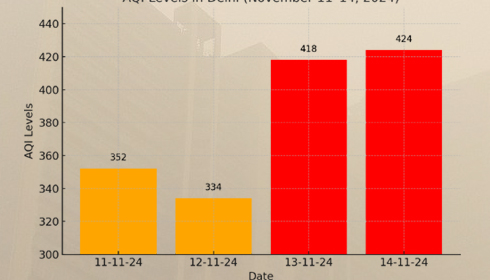
Delhi Chokes: Air Quality Plummets to 'Severe' with AQI Levels Soaring
The national capital's air quality deteriorated drastically in mid-November, with consistent "Severe" Air Quality Index (AQI) levels recorded on November 13 and 14. According to data from the Central Pollution Control Board (CPCB), AQI levels reached 418 and 424, respectively, categorizing the air as "Severe," and posing a severe threat to health. PM2.5 emerged as the dominant pollutant, known for its potential to penetrate deep into the lungs and bloodstream, causing grave respiratory and cardiovascular concerns.
Highlighting the situation, Delhi's Environment Minister, Gopal Rai, blamed the growing pollution on "seasonal weather changes and stubble burning." He clarified: "Recent snowfall in the mountains has caused a significant drop in temperature, leading to fog and low wind speeds that trap pollutants."
The week began with "very poor" air quality index scores of 352 and 334 on November 11 and 12, respectively, before worsening mid-week owing to stubble burning, temperature inversions, and stagnant air. The AQI slightly improved on November 15, achieving a classification of "unhealthy" at 237. However, some locations, like Alipur (331 AQI) and Ashok Vihar Phase I (315 AQI), remained very polluted, while Chanakya Puri had a slightly better AQI of 117, highlighting localized variances.
Delhi's environment minister, Gopal Rai, emphasized the government's proactive initiatives under the Graded Response Action Plan (GRAP-II), which include stringent anti-dust legislation and vehicle emission limits. "The Commission for Air Quality Management (CAQM) has decided not to deploy GRAP-III yet. We are strictly enforcing GRAP-II to avoid a serious situation," he said.
Health experts are concerned about the impact of PM2.5 and PM10, which were recorded at 109 and 151 µg/m3, respectively, on November 15. These small particles increase respiratory and cardiovascular difficulties, especially in youngsters, the elderly, and those with pre-existing diseases.
Experts say that people should limit outdoor activity, wear masks, and use air purifiers to reduce health hazards. However, experts warn that these temporary solutions are insufficient. Stronger industrial pollution restrictions and increased measures to reduce stubble burning are critical.
Rai emphasized his achievement in lowering stubble burning incidences in Punjab, which fell by 80% over three years—from 45,172 cases in 2022 to 7,492 in 2024. However, he highlighted an increase in incidents in Uttar Pradesh, emphasizing the importance of state-level collaboration. "Delhi is responsible for only 30% of its pollution. "Neighbouring NCR districts and states make significant contributions," he said, pushing the central government and states like Haryana, Rajasthan, and Uttar Pradesh to collaborate.
Delhi's air pollution crisis is a significant issue. While slight improvements in air quality provide immediate comfort, long-term development requires shifting to cleaner energy, developing green spaces, and improving monitoring systems. Minister Rai once again stated: "Reducing pollution requires collective responsibility and coordinated action from all stakeholders to safeguard public health and the environment."